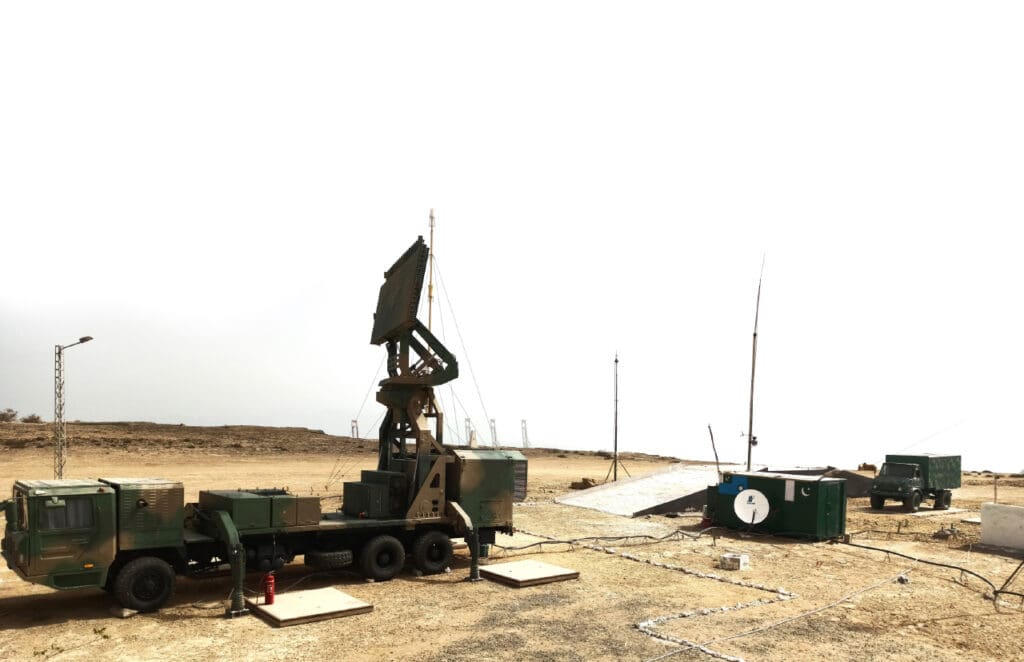Unveiling the Enhance of C2 System
In the fast-evolving world of aviation, where precision and coordination are paramount, the role of Command and Control (C2) systems cannot be overstated. These intricate networks serve as the unseen architects of aerial operations, orchestrating the movements of aircraft, monitoring airspace, and ensuring effective communication. In this article, we delve into the heart of PAF’s C2 systems, exploring their evolution, significance, and the transformation they have recently gone through in the past few years. From military air forces to civilian air traffic management, PAF’s C2 systems is a critical linchpin, and we’re about to take you on a journey through its complex world which recently underwent a revolution.
In the early hours of the morning on February 26, 2019, as the sun was yet to pierce the horizon, Pakistan’s Air Defence Operations Centre (ADOC) sprang to life. It was a day that would test the mettle of the nation’s defenders in the skies. Little did they know that their unwavering resolve would soon grant them a special place in the hearts of their countrymen.
High above, the radar screens in the ADOC displayed a blip, swiftly followed by another. The radars, PAF’s all-seeing eyes in the skies, had detected the intrusion of Indian fighter jets into Pakistani airspace. As the Indian jets crossed the Line of Control, Pakistan’s AOC was a hub of activity. The air defenders knew that they had to act swiftly, decisively, and with an unwavering commitment to protect their homeland. Information from multiple GMCCs, GRADs and other bodies flooded the ADOC and was quickly accumulated into a single package which would give an accurate picture of the scenario. Within minutes, the deliberation was complete and the orders for the air warriors to scramble was given. On the other side, the same readiness was maintained. The pilots were in the air within 5 minutes of the call, an impressive feat within itself.

The radar operators in the ADOC meticulously tracked the movement of the Indian aircraft, constantly feeding critical data to their counterparts in the cockpits of Pakistani fighters. This synchronized dance between technology and human skill was the very essence of their training, a testament to the well-developed systems that allowed such a swift and effective response. Finally, Pakistan’s fighter pilots engaged their Indian counterparts. The world watched as these brave individuals executed their mission with precision and restraint, exemplifying the professionalism of the Pakistani Air Force forcing intruders to call off their mission and drop their loads on uninhabited location and ran away.
The next day in the broad light Pakistan Air Force response was generated which was later known to the world as Swift Retort. In the midst of this high-stakes encounter, the Pakistani ADOC continued to play its pivotal role. It was the eye in the sky that guided the nation’s defenders, ensuring that they remained one step ahead of their adversaries. The radar screens continued to display the ebb and flow of the battle, defence systems constantly scanning the horizon and the situation, sensors active and broadcasting data across all platforms involved in taking crucial decisions in split seconds. All this and more happened behind the curtains, an unappreciated but crucial part of any operation.
As the day wore on, the world would come to know of the downing of two Indian jets and six bombs purposely dropped next to important military installations, a moment that would be etched in the annals of history. Amidst the headlines and geopolitical reverberations, it was the pilot’s and the faces on the front that was given credit, which was well-earned. However, very little was spoken of the ADOC personnel and the precision of their sensors and systems, without whom, this victory would not have been possible. However, this is the nature of the ADOC and its sister bodies, to operate in the background, gather intel and create a swift and effective response to win the day.
Command And Control
Enter any Air Defence Operations Centre (ADOC) of PAF, and you’ll be face-to-face with similar sights. With the rhythm of jet engines in the backdrop, the inside of an ADOC is a place of quiet but tangible power and calculated precision. To understand the vital role it plays, one must step into this world of radar screens, hushed conversations, and unwavering dedication.
One would be surprised at the high degree of activity he would see. Operators clad in military uniforms move with purpose; their eyes locked onto screens displaying a mosaic of data from GMCCs, civilian aviation bodies, radars and several other bodies that constantly sending in data to the ADOC. It is clear that these centres are the nerve centres of PAF’s air operations, where decisions carried the weight of national security.
The heart of PAF’s Air Defence are its radar systems. As soon as enter an ADOC, you’re greeted by a bank of screens, each representing a radar station. These radars are our sentinels across the nation. They continuously scan the skies, monitoring every aircraft, every blip, every movement. They provide us with a real-time picture of what’s happening in the nation’s skies at any given second. These radars, positioned strategically across Pakistan’s vast expanse, are the first line of defence. They scan the skies with an unblinking eye, ensuring that no intruder goes unnoticed. The data they provide is relayed instantly to the ADOC, where it is meticulously analysed and acted upon. But ADOC goes far beyond mere surveillance. It’s a place of coordination and communication. It’s where intelligence meets strategy, where raw data is transformed into actionable insights. The men of ADOC are not just passively watching, they’re constantly orchestrating. When a threat is detected, it’s these men who that decide how to respond.
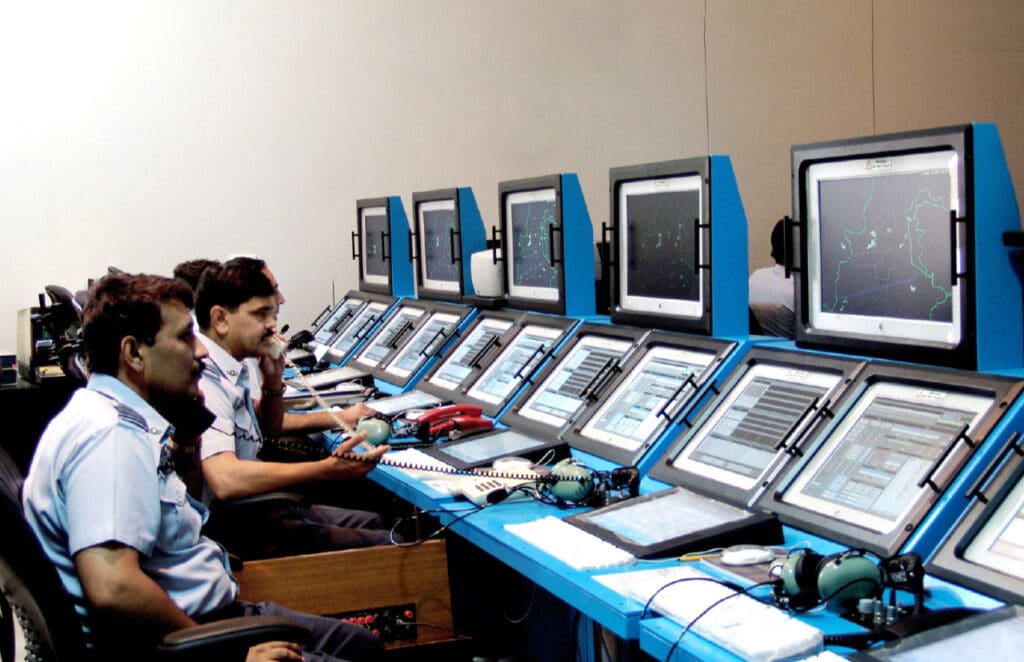
Behind the radar screens and communication equipment are the dedicated men and women who operate them. Their training is rigorous, and their commitment unwavering. These experts work in back-to-back shifts, ensuring that the ADOC is operational 24/7, 365 days a year. They are experts in their field, capable of handling high-pressure situations. Their attention to detail is unmatched, and their ability to make split-second decisions can be the difference between life and death in the air. As you venture into their world, you can’t help but feel a deep appreciation for the men and women who work tirelessly behind the scenes to ensure the safety and security of Pakistan’s skies. Their story is one of great importance but is rarely told, a story that unfolds silently but resolutely, behind the scenes, every single day.
The Air Operations Centre (AOC) in the Pakistan Air Force (PAF) is a critical element of its Command and Control infrastructure. The AOC is responsible for planning, coordinating, and executing air operations, and it plays a central role in the PAF’s ability to defend Pakistan’s airspace and protect its national interests. Some of the roles and functions that lie under the AOC involve:
Strategic Planning
The AOC is responsible for developing strategic plans for air operations, including mission objectives, target identification, and resource allocation. This planning process involves assessing potential threats and determining how best to use PAF assets to achieve mission success.
Surveillance and Reconnaissance
The AOC maintains a comprehensive picture of the airspace over Pakistan and its neighbouring regions. This includes monitoring radar and other sensor data to detect any potential threats or unauthorized intrusions into Pakistani airspace. Surveillance and reconnaissance assets, such as aircraft and ground-based radar systems and various other bodies, feed critical information packets constantly to the AOC.
Air Traffic Management
The AOC manages and controls the flow of PAF aircraft, ensuring safe and efficient operations within Pakistani airspace. This involves coordinating the movements of military and civil aircraft to prevent collisions and conflicts while facilitating mission execution.
Combat Operations
During combat operations or exercises, the AOC provides command and control for PAF fighter aircraft, bombers, and other assets. It directs these assets to their targets, coordinates with ground forces or other branches of the military, and ensures that missions are executed according to plan.
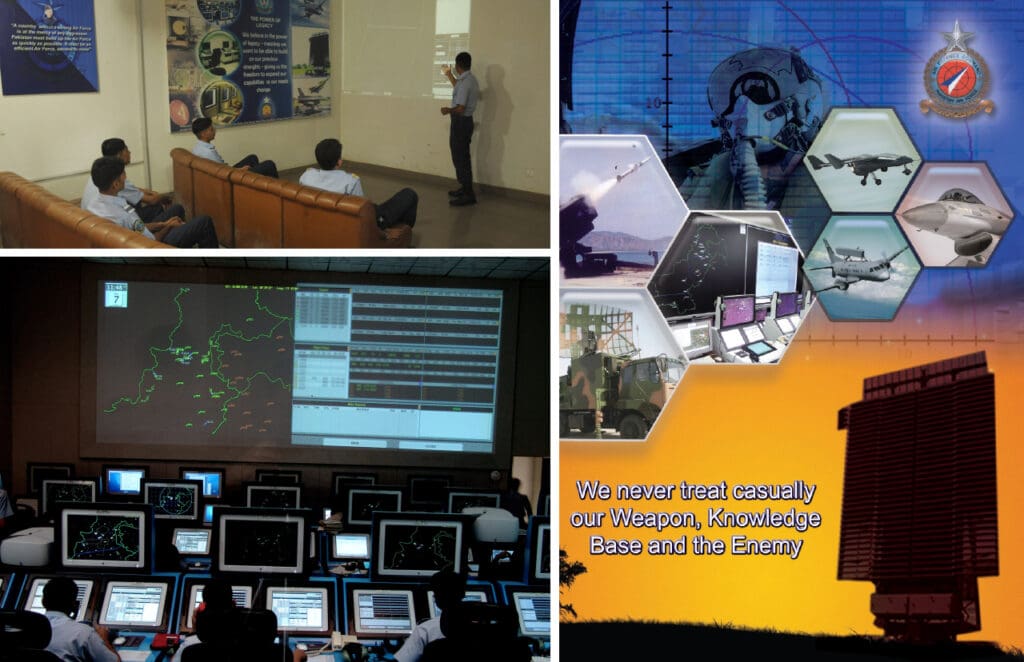
Communication and Data Sharing
Effective communication is vital within the AOC and between the AOC and various units throughout the PAF. The AOC relies on advanced communication systems to exchange information, issue orders, and maintain situational awareness.
Resource Allocation
The AOC allocates resources, including aircraft, munitions, and personnel, to support various missions and operations. This involves prioritizing and optimizing resource utilization based on mission requirements.
Threat Assessment
The AOC continually assesses threats within its operational area, tracking the movements of potential adversaries and making decisions to protect Pakistani airspace and interests. It also develops strategies to counter potential threats.
Situational Awareness
Maintaining a real-time and accurate picture of the operational environment is crucial. The AOC gathers and analyses data from various sources to provide decision-makers with situational awareness, enabling them to make informed decisions quickly.
Joint and Allied Operations
In cases where PAF operations involve coordination with other branches of the military or allied forces, the AOC plays a central role in ensuring effective cooperation and integration of assets.
Cybersecurity
Given the increasing importance of cyber operations, AOCs in modern air forces also have a role in protecting their own networks and information systems from cyber threats.
The specific structure and capabilities of the PAF’s AOC may vary based on its operational needs, available technology, and resources. Still, it serves as a critical nerve centre for the PAF’s air operations, ensuring the effectiveness and success of missions and the defence of Pakistan’s airspace.
Changing Winds
Like every other sphere in the world, aviation technology is constantly changing, as well. With the advent of stealth technology, ballistic missiles, UAVs and various other new advancements, PAF has made incessant efforts to keep itself abreast with the latest systems. This is not only true for the aircraft and other weapon systems but also for other areas. But as we gaze into the future, the very landscape of air battle is shifting beneath our feet, promising more profound changes. Emerging Disruptive Technologies (EDT) are the driving force behind this transformation, offering greater precision, unprecedented speed, and an autonomy that will reshape the very essence of air power. The integration of Artificial Intelligence (AI), Unmanned Aerial Vehicles (UAVs), Low Observable Technology, and the advent of Hypersonic weapons heralds a new dawn in aerial warfare. These innovations promise to make air power even more assertive, and the skies more fiercely contested.
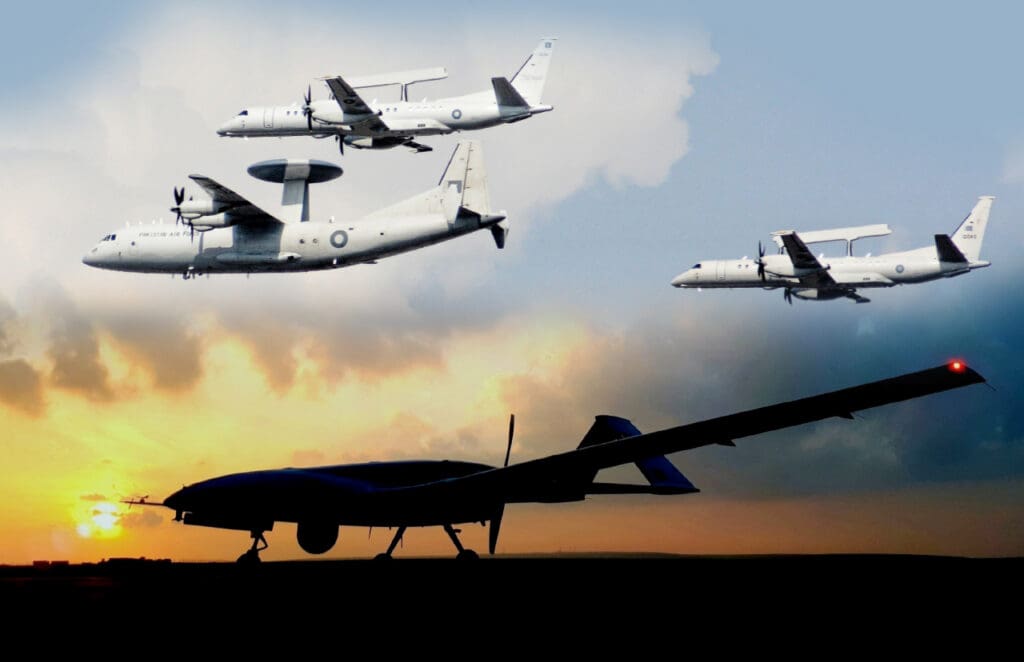
While the PAF has always stood as a formidable guardian of Pakistan’s airspace, it was not impervious to the existence of cracks and blind spots within its operational framework. The shifting geopolitical landscape and emerging threats demanded an urgent response, inspiring a relentless pursuit of training excellence and technological advancement. In the face of these rapid changes, the Pakistan Air Force (PAF) recognizes the imperative for a paradigm shift.
The character of war is evolving, and PAF must evolve with it. No longer can it remain a conventional air force in the traditional sense. It must rise to the challenge of countering threats not only in the skies but also in the vast expanse of space. PAF has embarked on a journey of transformation that will see it take a lead role in multi-domain operations, working in synergy with other armed forces and government agencies, including SUPARCO, AWC, and SPD. The future demands a balanced mix of armed forces capable of operating across multiple domains, and PAF is prepared to lead the way.
Charting a Course for the Future
To successfully transition into a futuristic air force, PAF needs a comprehensive roadmap that takes into account fiscal constraints and the nation’s needs. In line with the vision of Chief of Air Staff Zaheer Ahmad Baber Sidhu NI(M), PAF has identified key principles that will guide the transformation of its Air Defence. Multi Domain Operability, Indigenization, Integration, Automation, and Resilience are the cornerstones upon which the future of PAF’s Air Defence will be built. These principles represent the true north that will guide PAF through the uncharted territories of tomorrow’s air battles.
State-of-the-art C2 Centres
The heart of PAF’s operational capabilities, the Command and Control (C2) system, is also undergoing a revolution. The goal is clear: enhanced situational awareness, rapid response, and seamless interoperability. These upgrades are not just about technology; they are about ensuring timely and correct decision-making by commanders, especially in moments of crisis.

At the top of the C2 hierarchy, the Air Defence Operations Centre (ADOC) and Command Operations Centre (COC) are witnessing a transformation. Previously limited in their capability to display vital information, these centres are now undergoing a systematic overhaul. The integration of artificial intelligence-based applications into the Common Operating Picture (COP), along with several other upgrades, is poised to be a game-changer.
The Command Operations Centre (COC), the nerve centre for all Air Operations related to the execution of War Plans and Contingencies, is also receiving a significant upgrade. The newly developed National Aerospace Science & Technology Park (PAF NASTP) has taken up the responsibility of designing and constructing a fortified C2 centre. This facility will be equipped with all the essential components required for contingency handling, ensuring quick assessments of developing situations and rapid C2 responses in times of crisis.
As the future of Air Operations leans increasingly on Command and Control Centres, adaptability and mobility are crucial. Recognizing the importance of C2 Centres and their vulnerability in hostile scenarios, PAF has launched the Next Gen Mobile Mission Control Centre (NG-MMCC). This advanced facility boasts secure plug-and-play data/voice networking, network security, and resilience. Its integration of AI-based Decision Support Tools (DSTs) and rapid mobility with reduced footprints promises enhanced operational effectiveness. Talking about DSTs, one of the most important aspects of the upgradation process is the integration of Artificial Intelligence. The development of AI-Based Decision Support Tools (DSTs) is well underway at CENTAIC.
Sensors and Shooters
The 2nd May incident in Abbottabad served as a wake-up call for the Air Force, highlighting a plethora of red flags on strategic and capability levels. Action was taken immediately to rectify the situation. At the centre of this upgradation was the enhancement of PAF’s sensor grid.
As part of the Air Defence modernization program known as PADS-2020, PAF inducted state-of-the-art Multi-Role Radars (MRRs) into its arsenal. Among these were the TPS-77 MRR and YLC-18A radars, each a marvel of modern technology. These sophisticated instruments were not just a technical achievement; they opened up new vistas of operational flexibility. PAF’s visibility across its frontiers, especially in challenging terrains like valleys, received a substantial boost, granting valuable reaction time. The detection of an Indian BrahMos missile misfire highlighted PAF’s newfound capabilities. These MRRs proved their mettle by operating flawlessly in diverse environments, countering threats ranging from low-RCS (Unmanned Aircraft Systems, missiles, and low RCS aircraft) to high-speed hypersonic missiles and slower-moving targets like drones and balloons.
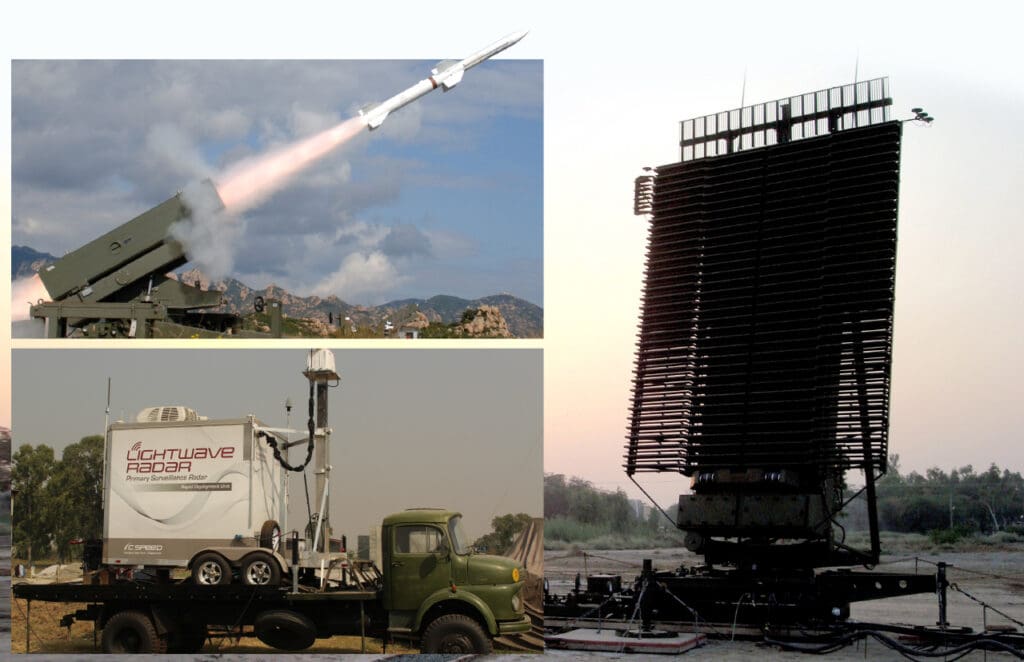
Adding another layer to its defence, PAF welcomed a cutting-edge UHF 3D radar. This radar system incorporated advanced two-dimensional digital active phase array radar technology, further enhancing its capabilities. But what truly set it apart were its robust anti-jamming features, providing PAF with the ability to operate even in dense Electronic Attack (EA) environments. With this induction, PAF acquired an extended range for detecting stealthy and small RCS (Radar Cross-Section) flying objects. In an era where stealth technology poses a significant threat, this radar system offered a crucial advantage.
The importance of High-Mobility Artillery Rocket Systems (HIMADS) cannot be forgotten in the current era. After careful study and evaluation, PAF finalized the HQ-9B/E system, signing the necessary contracts. This versatile system is designed to intercept Fighter Aircraft, Cruise Missiles, and Theatre Ballistic Missiles at various altitudes. What sets it apart is its ability to engage multiple targets simultaneously, making it an invaluable asset for both theatre defence and point defence. In an era where threats can come from multiple directions simultaneously, such capabilities are paramount.
Such upgrades cost a hefty amount of capital. With the nation strapped for finances like it is now, any induction can be a strain. That the reason PAF always strives for indigenous development of new assets.
Collaborating with institutions like PAF NASTP (National Aerospace Science & Technology Park) and AWC (Air Weapon Complex), alongside other defence production units, PAF is actively involved in the development of VHF and Low-Level Radars. One such indigenous low-level radar system has already achieved major milestones and is currently in the evaluation phase. This strategic move aims to reduce dependence on foreign sources for sensor procurement and maintenance, ensuring operational autonomy.
Training
Chief of Air Staff Zaheer Baber Sidhu NI(M) has given unrelenting emphasis on the importance of upgrading the PAF training regimes. This vision is the driving force behind the heavy modifications made to the training programs of all aviation and PAF programs across the nation.
Inductees of the Command and Control training programs are no exception. At the heart of this transformation stands the Air Battle Management School, a cutting-edge facility aligned with the aspirations of the Chief of the Air Staff. Nestled within the PAF Air Power Centre of Excellence, ABMS has emerged as a crucible for honing the skills of combat crew in a dynamic operational environment.
Here, airmen and airwomen delve into the intricacies of air space management, the intricate art of deploying Ground-Based Air Defence Systems (GBADS) and various other crucial skills. But what sets ABMS apart is its fusion of live exercises with state-of-the-art simulations. It’s a one-stop-shop for training solutions catering not only to the PAF but also to tri-services and allied forces.
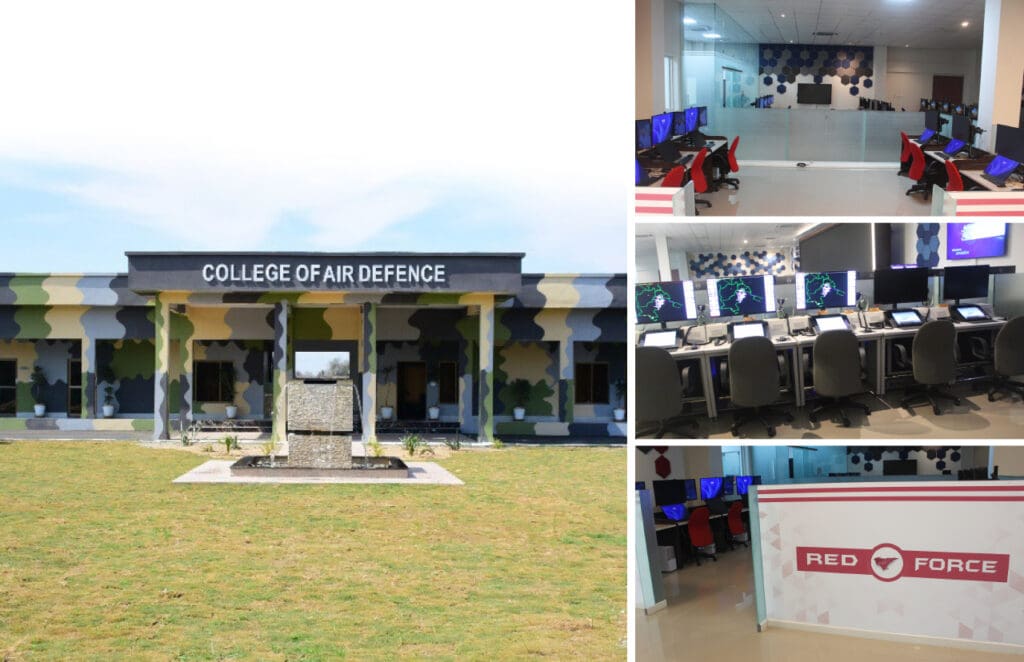
Within the ABMS, the Joint Strategic Simulation Centre (JSSC) is a division designed to provide PAF combat crew with a high-tech playground for honing their skills. It’s a world of synthetic training that replicates contemporary warfare scenarios, fostering joint exercises involving PAF, tri-services, and allied countries’ officers. Envisioned by the CAS himself, JSSC serves as the nexus for training combat crew and battle-staff in modern, centralized next-generation systems for effective offensive and defensive multi-domain Command and Control operations. This capability has found its place in numerous national and international exercises, amplifying the live segment of air force employment.
Similarly, the College of Air Defence (CAD) is also a testament to PAF’s commitment to providing centralized, modernized, and institutionalized basic and system training. Nestled within the Pakistan Air Force Academy (PAFAA), CAD boasts state-of-the-art facilities catering to cadets, Under Training Officers (UTOs), and Air Defence (AD) Officers. CAD comprises three distinguished schools: the Air Defence Training School (ADTS), the School of Air Defence Operations (SADO), and the Air Defence Systems School (ADSS). It is also home to a state-of-the-art, fully indigenous Joint Strategic Simulation Centre. Notably, this centre doesn’t just fulfil basic training needs but also acts as a strategic simulator for complex joint-services-level exercises.
The training regimes has recently had another major boost in their effectiveness with the addition of Air Force Integrated Synthetic Training Environment (AFISTE) in their trainings. This entirely indigenous simulation system revolutionizes PAF’s synthetic training, propelling it towards Live, Virtual, Constructive (LVC) training. The system is a networked marvel, even allowing the training of combat crew from remote locations.
A Skyward Journey into the Future
In conclusion, PAF’s modernization efforts aren’t confined to equipment and tactics alone. They encompass an equally vital aspect—training. The emphasis is on elevating situational awareness, enhancing decision-making agility, and optimizing the coordinated use of various weapon systems through a network-centric command and control system. Integrated radars, early warning systems, advanced communication networks—they are all woven into this transformative tapestry. This convergence ensures an unparalleled understanding of airspace, timely threat detection, and a rapid response mechanism. But the most intriguing element is the infusion of artificial intelligence and machine learning into air defence systems, empowering predictive capabilities and proactive responses.
In the ever-evolving arena of modern warfare, PAF leadership’s unwavering commitment to modernization leads to an impenetrable defence of Pakistan’s skies and its sovereignty.
